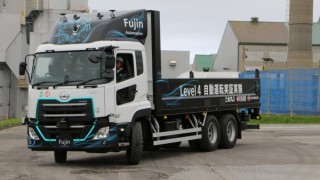Loading
Search
▼ Graying Japan Faces Urgent Need To Realize Autonomous Transportation
- Category:Other
With an aging population and a growing shortage of drivers, Japan is a country where autonomous transportation services would seem to have a bright future.
Demand is particularly high for self-driving trucks in regions with few alternatives to hauling freight by road, such as the northern main island of Hokkaido.
Among truck manufacturers, UD Trucks Corp., a Japanese unit of Sweden's AB Volvo, has teamed up with an agricultural cooperative in Hokkaido that is increasingly concerned about the declining number of delivery truck drivers.
The company has been testing its autonomous heavy-duty trucks on a 1.5-kilometer designated route in and around a sugar factory in Shari, eastern Hokkaido. In a recent demonstration, a truck traveling at a speed of 20 kph successfully navigated its way to a beet processing plant using a global positioning system and sensors.
The truck is capable of Level 4 self-driving, meaning it performs all driving tasks without human intervention within a limited area, even in emergencies.
The Japanese truck maker claims to have conducted the first autonomous trial using a large truck with Level 4 technology in Japan. A Volvo group firm is also conducting Level 4 tests at a limestone mine in Norway and a sugar cane plantation in Brazil.
https://youtu.be/IDS_Axnydzg
"I hope self-driving technology will be realized soon as (driver shortages) will affect the logistics of farm products in Hokkaido," he added.
Hokuren says 250 trucks a day operate at the Shari factory alone when the sugar beet harvesting season starts in October.
Hokkaido, the country's largest farming area, grew rice, vegetables and dairy products worth more than 1.2 trillion yen in 2017, double the production of Kagoshima, the second biggest agricultural prefecture, in southwestern Japan.
Hokuren's Uchida said, however, that the northern prefecture's shrinking labor force is a serious threat to the region's economy. Hokkaido's population of 5.30 million as of Jan. 1 represents a 7 percent drop from a peak of 5.69 million in 1997, according to Ministry of Internal Affairs and Communications data.
"Hokkaido sends about 3.5 million tons a year of farm products to the rest of Japan and the world. Maintaining our logistical capability is vitally important," he said.
UD Trucks plans to launch commercial operations of Level 4 autonomous trucks, such as in a factory and a port, next year at the earliest.
"We would like to introduce (Level 4) self-driving trucks step by step, starting from a confined area," UD Trucks President Takamitsu Sakamaki said in a press conference in August.
Experts say that autonomous driving is already an in-demand technology and is no longer something to think about for the future.
"The key element in commercial use is whether autonomous driving technologies will significantly cut personnel costs and contribute to customers' business solutions," said Hitoshi Kaise, partner at consulting firm Roland Berger.
"It is important to offer demand-driven services at the right time."
Kaise said development of autonomous driving technologies in Japan are expected to draw attention from the rest of the world as "they could also be solutions in other advanced countries to address challenges posed by the graying and decreasing population," he added.
Some companies in the automated vehicle technology field are at more advanced stages of development including Daimler AG, which has already started testing its Level 4 heavy-duty trucks on public roads in the United States, but developers around the world still face many technological hurdles.
SB Drive Corp., a subsidiary of major Japanese wireless carrier SoftBank Corp., has been grappling with complex road and traffic situations in its development of autonomous buses with France's Navya SA.
It has organized more than 50 trials of self-driving buses with the participation of over 12,000 residents across the country since 2016. In addition, it has been operating three autonomous electric minibuses at the Fukushima Daiichi nuclear complex, crippled by the March 2011 earthquake and tsunami disaster, from April last year to transport workers engaged in decommissioning work.
The 11-seat minibuses are often forced to stop unexpectedly when they encounter a pedestrian or cyclist in their path or when reception of GPS signals becomes unstable, said Atsuto Suyama, chief technology officer at the company.
To commercialize self-driving vehicles, improvements are also needed in the way vehicles communicate, he says. Human drivers can make contact with each other using gestures or eye contact, but autonomous vehicles cannot do so unless they are connected and continuously exchange data. "It will take more time to launch unmanned vehicles on public roads," he said.
Takekazu Inoue, senior specialist at the Japan Research Institute, says Japan is going to face a "mobility crisis" and the country needs to take the issue more seriously.
As baby boomers born after World War II reach their 70s, seniors' access to transportation will become a more pressing issue, he said.
"The less people move around, the smaller the economy becomes," Inoue said.
"Autonomous vehicles will need at least 10 more years to spread in Japan. Addressing transportation shortages, especially in the outskirts of big cities, will be very challenging."
One proposal Inoue has for tackling this challenge involves fuel taxes. Revenue from taxes on gasoline and diesel fuel is currently used for road construction as well as general purposes unrelated to road transport, but Inoue believes the government should use a portion to give a funding boost to mobility solutions.
"It is far more important than building more roads," he said.
- September 20, 2019
- Comment (0)
- Trackback(0)


